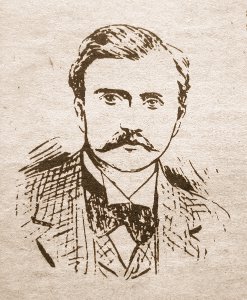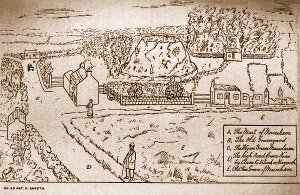A Divisive County Kildare Parliamentary Election from July 1892
Published in ‘Local History Review’ Vol. 15, 2010
One of the most bitterly fought elections in the history of Kildare electoral contests occurred in July 1892 for the Westminster constituency of Kildare North. The battle for the seat was between James Laurence Carew, the outgoing MP, and the challenger Patrick Kennedy. County Kildare was divided into two parliamentary constituencies, Kildare North and Kildare South. The contest in Kildare South was between two candidates from the Athy area, the outgroing MP James Leahy and his former election agent Matthew Minch. This contest did not seem to have the same bitterness as the election in North Kildare.
At that time there was a sharp political divide in every constituency in the country between Parnellite and Anti-Parnellite candidates. The events surrounding the Parnell and Kitty O’Shea scandal in 1890 had led to the split. Although Parnell had died in 1891 the rift between the opposing parties continued to widen. Every district in the North Kildare constituency was sharply divided over the issue with the rift dividing families and neighbours alike.
It appeared that Mr Carew’s position as an MP was fairly secure in Kildare North as he had had good credentials. He was well known, he had gone to jail for tenants’ rights and as the owner of the Leinster Leader newspaper, he controlled the nationalist media in County Kildare. Nevertheless because he sided with Parnell at the time of the split he had lost the support of the Catholic clergy and also lost substantial support from the electorate in the constituency. When the general election was announced in May 1892, there was a strong feeling in the constituency that the seat should be contested. The anti-Parnellite party, ‘The Irish National Federation’ then organised a Convention to be held in Kildare Town to choose a suitable candidate to oppose Carew. However, in order to avoid a bitter divisive contest at the Convention between aspiring candidates who by all accounts were not of parliamentary standard, a private convention or ‘caucus’ was held on Sunday, the 5th of June. The venue was the ‘Old Chapel in Clane’. This building had been disused from the time a new Parish Church had been built eight years previously in 1884. The site of this Chapel is in the area between the entrance to the present Parish Church and the entrance gate at the Main Street.
The caucus was well attended with at least 54 delegates present, including seven or eight priests. It was reported that eleven or twelve parishes in the constituency sent delegates and that only one parish was not represented. The average number attending from each parish was between four and five delegates. The merits of several candidates were discussed at great length with the debate, according to one source continuing ‘for two to three hours’. Finally it was resolved to nominate Patrick Kennedy from Rathcore, Enfield. His selection was a surprise as he was inexperienced, youthful and a relatively unknown figure outside County Meath where he was prominent in local politics. However, he emerged with unanimous support and was recommended by the delegates to the convention in Kildare Town.
The convention was held on the 13th of June and Mr Kennedy was duly ratified as a candidate to oppose Mr Carew. Among those attending were the two curates from Clane, Rev J. Kirwan and Rev J. Dunne.
Kennedy addressed the conference and suggested that he was confident of victory because, as he put it, he knew the calibre of those who were opposed to the anti-Parnellites. However, he controversially described his opponents as ‘every little shoneen, every would-be gentleman, every land grabber and every discontented crank throughout the length and breath of Kildare’. Tough words for a newcomer to elections and very colourful language indeed, however, remarks of this nature were to become a feature of the election.
A response from Carew came shortly afterwards. He chose a public meeting in Clane to reply. Outdoor public meetings in Clane were usually held in the village green with a platform erected at the highest spot close to what was described at the time as the entrance into the graveyard beside the de-roofed Protestant Church. The meeting on the 9th of July was well attended and chaired by a local man, J.D. Whyte from Firmount. In his opening address, Carew suggested that Kennedy in his first address to the people of Kildare insulted them by referring to the Parnellite supporters ‘as shoneens and discontented cranks’. At this point a voice from the crowd heckled an insinuation that ‘Kennedy was thinking of himself’. Carew also addressed the issue of lack of clerical support for his candidature. He insisted that he had no quarrel with the clergy and emphasised that he had been educated in a Jesuit College. This was a reference to his education in Clongowes Wood and an acknowledgement that he was not anti-clerical. In the Clane area, supporters of Carew were of the opinion that Kennedy would not have got a nomination in his own native county and accused him of been a turncoat. Carew highlighted this issue and insisted that Kennedy was a Parnellite up to a short time ago until he got the offer of this seat. At this point a voice from the crowd shouted, ‘we’ll hunt the rat’. It was not unusual for insulting remarks of this nature to be made at election meetings at the time. Other abusive remarks from Parnellites referred to Kennedy as ‘a bounding kangaroo from Australia’ and ‘Mr Jump-Jim-Crow-Kennedy’. The remarks were obviously a nineteenth century reference describing the modern term for one who is parachuted into a constituency.
Kennedy replied to the remarks at his next public meeting when he accused Carew of making a shameful and base attack on him in double-headed type in what he referred to ‘as this week’s Leinster Leader rag’. The article in question had cast doubt on the fact Kennedy had served as a secretary of a local branch of the Land League since he was eighteen. Kennedy insisted that there was not one word of truth in all that the newspaper had written about him and he made a counter attack on Carew by questioning his knowledge of tenant farmers. He indicated that Carew had never spent any time in this country since his boyhood years and suggested that he went straight from Clongowes to London.
Carew’s close friend from his student days and fellow Clongonian John Redmond, the leader of the Parnellite party, now joined in attacking Kennedy. He attended a meeting with Carew shortly afterwards in Naas and launched a bitter attack on the inexperience of Kennedy whom he described as ‘Kennedy who? Who never did anything for the cause and was a political Omadhaun’.
Candidates for election at the time were usually proposed and seconded by individuals from a number of different areas. The various nominating pagers were then signed by a number of assenting nominators. One of the nominating papers for Kennedy was from the Clane district where he was proposed by the Parish Priest Fr. James Colgan and seconded by the senior curate Fr. J. Kirwan. This paper was signed by assenting nominators, which included many prominent voters from Clane and the surrounding district. Prominent individuals in the Clane district who were supporters of the Parnellite faction signed one of Carew’s nominating papers.
The hotly contested election was won convincingly by Kennedy amid claims of both intimidation and abuse of illiterate voters. When news of Kennedy’s victory reached Clongowes Wood College just outside Clane, the employees both indoor and outdoor, were given a half day’s holiday and they immediately began to celebrate. Clongowes was very anti-Parnell despite the fact that James Carew and John Redmond had been educated in the college. Patrick Kennedy on the other hand was a past pupil of Castleknock College and had no connection with Clongowes.
The Clongowes employees decided to celebrate in style. It was first intended to celebrate in Clane but it was eventually decided to hold the celebrations locally. They collected fire-wood and gas-tar from the precincts of the college grounds and built a massive bonfire close to the main entrance into the college at Mainham Green. This area of common land is all that remains of the once thriving medieval town of Mainham, which is said to have been destroyed in the distant past by a plague. Despite the fact that at least two local publicans were Parnellite supporters, the anti-Parnellite group acquired a half-barrel of porter to add to the excitement of the celebrations around the bonfire. An onlooker described that the porter was consumed with ‘great gusto’.
While the preparations were progressing the newly elected MP Patrick Kennedy drove past in his carriage on his way home to Rathcore from the count centre in Naas. He was immediately approached by his celebrating Mainham supporters and invited to what was described by one of the men present to ‘contribute something, to the bonfire’. However, Mr Kennedy continued on his journey without contributing. At this point one of his supporters was heard to say, ‘Ah sure your honour’s not going away like that?’ It appears that the newly elected MP did not want to get involved in the celebrations especially with alcohol as a factor. This did not go down well with his celebrating supporters and some members of the group obviously much the ‘worse for drink’ accused him of been ‘a mean mushroom crusher’ and that another day will come. Despite this, the fun progressed in a fast and furious manner. Great anger was shown against the local Parnellite supporters even to the extent of making effigies, which were then consumed in the bonfire flames amid general jubilation. Among the effigies burned were those representing the persons of well-known farmers and at least two local publicans, including one whose premises were within sight of the bonfire. Many local anti-Parnellites returning home to Rathcoffey from the counting centre in Naas arrived at the bonfire and although too late to avail of the refreshments they nevertheless participated in the jubilant celebrations.
The hecklers at Mainham were correct in stating that ‘another day will come’ as Kennedy only served three years as an MP, retiring at the end of the election term. Although Carew was defeated again in Kildare North in the following election, he subsequently served as an MP in South Meath, Kennedy’s home constituency. Within eight years the split between the Parnellite and anti-Parnellite groups had ended with John Redmond becoming leader of a united party.
Mainham Green has seen many important events in its 2000 years of history including; the death of Queen Buan in the pre-Christian period; the destruction of the settlement by Gaelic Chieftains in the 13th century, and in the 18th century a squabble between a rector and a landlord, which led to the building of the Wogan-Brown mausoleum. However, the celebrations by the anti-Parnellites in 1892 certainly lived up to the reputation this area has always had in creating a unique and spectacular history in every era.


